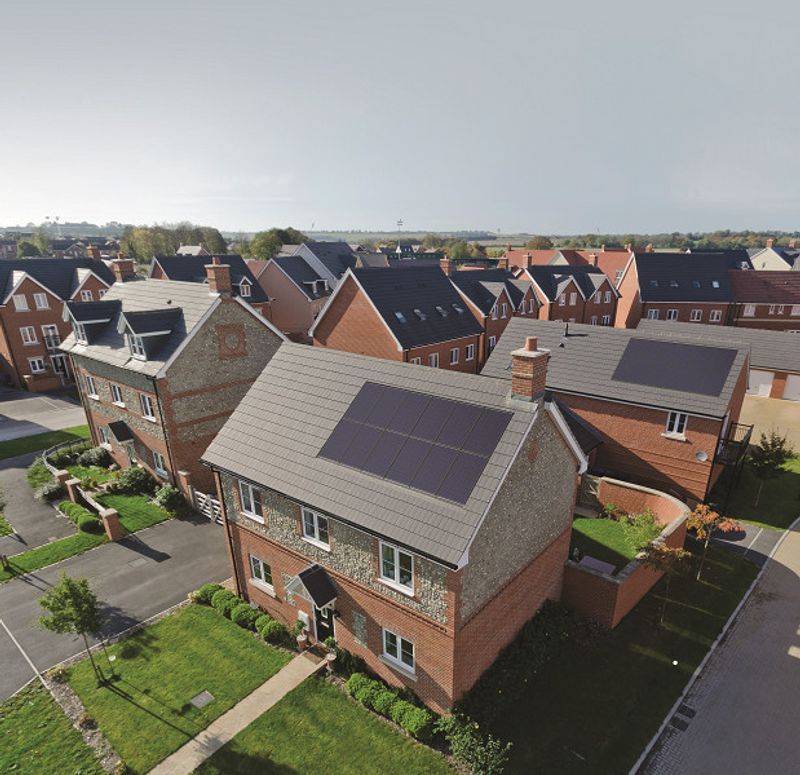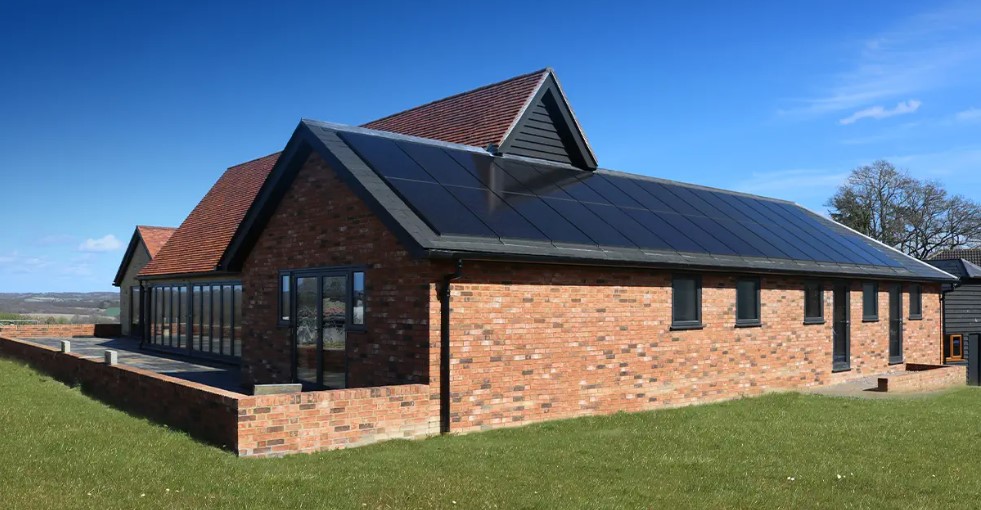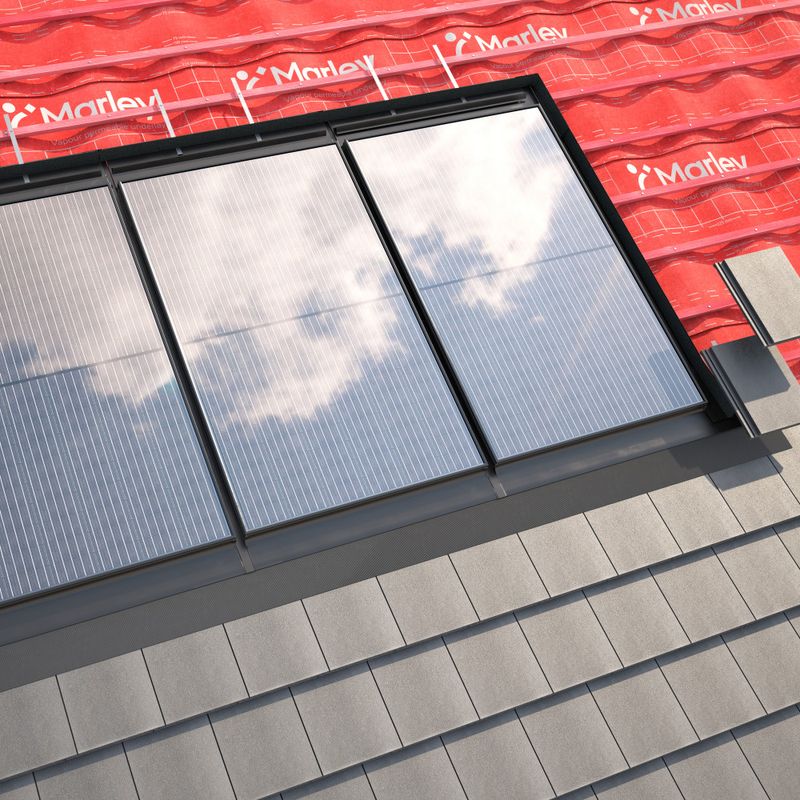There are so many positives associated with solar roof tiles. So, where do you even begin when learning more about them? What even is a solar roof tile? Well, that’s where our buyer’s guide comes in.
We’ll explain what solar roof tiles are, including average costs and where you can buy these useful technologies. Read on to learn more and make an informed decision for your future purchase.
Table of contents
- What are solar roof tiles?
- Types of solar roof tiles
- Solar roof panels vs solar roof tiles
- Where to buy solar roof tiles
What are solar roof tiles?
Solar roof tiles, also known as solar shingles or (if you’re feeling fancy) photovoltaic roof tiles, are innovative green energy technologies.
Solar panels have become hugely popular in the last decade (especially in the UK). Now there’s more efficiency than ever with a massive 82% reduction in costs. We even saw a 29% increase in solar energy production in 2022 alone. So, there’s definitive evidence solar products are making a positive impact.

Instead of having a chunky, protruding solar panel sticking out from the roof, solar tiles are a seamless alternative. This is perfect if you live in areas that value heritage or conservation. You can even use them if you’re only concerned about how the outside of your home looks.
They still work like traditional panels, too, converting sunlight into electricity.

How efficient are solar roof tiles?
What do all the statistics mean? Well, let’s look at Marley’s Solar tiles’ performance rating as an example.
These solar tiles are highly efficient in all weather, with exceptional fire performance, wind resistance and weather tightness. When put together, Marley solar tiles have a superb efficiency of 20.7%. Peak power can be as high as 335wp (watt peak). So, it’s worth the investment. With that said, what is the cost of solar roof tiles?

How much do solar roof tiles cost?
As a modern technology, typical prices (including VAT) can vary between £5,500 and £17,000. On the extreme end, this can be up to £55,100 or more (we’re looking at you, Tesla).
The total cost will depend on the system size (what kWp (kilowatt peak) you’re looking for) and labour costs. The above does not include these and can be anything from £1000 to £2000 or more. So, you must make sure you take this into account.
So, to avoid any hefty replacements in the near future, check out our solar tile aftercare guide.

Types of solar roof tiles
Did you know solar roofing isn’t just one singular style? If not, now you do!
Solar roof panels are categorised into three separate generations. Here’s a breakdown of the different generations and their varying qualities.
However, if you already know what type of solar roof tile you want but not sure how many you need, check out our guide to help you figure out what amount is necessary for your property.

First-generation solar panels
These are traditional solar panel materials. What you could call the ‘grandparents of solar panels’. Specifically monocrystalline silicon or on or polysilicon, and commonly used in conventional settings. So, what sets them apart?
| Monocrystalline solar panels (aka Mono-SI) | Polycrystalline solar panels (aka Poly-SI) |
| •Considered the purest type of solar panel. •Easily recognised by its clean, dark look and round edges. •One of the highest efficiency rates because of the silicon’s high purity (modern ones reaching over 20%. •High power output. •Uses less space. •Longest lasting type. •Fewer problems with high temperatures when compared to Poly-SI. •Can be expensive. | •Easily recognised by the squares with angles that are not cut and a blue, speckled appearance. •Manufactured by melting raw silicon which is a faster and cheaper alternative than Mono-SI. •Cost-effective but reduced efficiency. •Uses more space. •Short lifespans as they have more problems with high temperatures. |


Second-generation solar panels
The next generation of solar panels is cells made using thin film solar cells. Commonly used for photovoltaic power stations, but also used for integration in buildings or smaller solar systems.
| Thin-Film Solar Cells (aka TFSC) | Amorphous Silicon Solar Cell (aka A-Si) |
| •Cost-effective. •Manufactured by placing one or more films of photovoltaic material onto a substrate (this could be silicon, cadmium or copper). •Easier to produce and uses less material for production meaning cheaper costs. •Flexible meaning can be used for a variety of applications. •Less affected by high temperatures. •Uses up more space so not typically suited to residential fittings but better for areas with a lot of space. •Shorter warranties due to a shorter lifespan. | •A common solar panel that is used mainly with solar-powered pocket calculators. •Uses triple layered technology – argued one of the best thin film varieties (thin = one micrometre for this type). •Less effective than crystalline silicon film but more cost-effective. |

Third-generation solar panels
The third generation is really ramping up the power solar support has in the energy-saving industry. So, what do we have here?
| Biohybrid Solar Cell | Cadmium Telluride Solar Cell (CdTe) | Concentrated PV Cell (CVP and HCVP) |
| •Still in the early stages of research. •Uses the photosystem one to emulate the natural processes of photosynthesis. •Uses many traditional method materials but only combines multiple layers of photosystem one, so chemical-to-electrical energy conversion is much more effective. | •Photovoltaic solution using Cadmium Telluride – this enables solar cells to produce in more cost-effective ways. •Low-cost solution means shorter payback time. •Requires the least amount of water to produce. •Helps decrease carbon footprint to low levels. •Cadmium Telluride material can be toxic if ingested or inhaled. | •Known as multi-junction solar panels •High efficiency rate which, amongst all photovoltaic systems, is the highest (so far). •CVP refers to ‘curved mirror surfaces (sometimes known as lenses or even cooling systems) •Curved mirror surfaces bundle the sun rays which increases efficiency. •Can only be efficient if facing the sun at a perfect angle. •A solar tracker inside the panel follows the sun to help reach high efficiency rates. |
Solar roof panels vs solar roof tiles
One of the most obvious benefits is solar roof tiles are they can be more discrete. However, both have their merits. Here’s a brief overview of the contrasts between solar panels and solar tiles.
| Solar roof tiles | Solar roof panels | |
| Design | •Discrete panel design with the potential to increase property’s market value. | •Protruding panel design. |
| Cost | •High initial cost •Can be eligible for incentives provided by the government. | •Cost effective. |
| Durability | •High resistance and high strength. | •More prone to extreme weather damage. |
| Installation | •Not compatible with every roof – suitability typically applied when building new properties or entire roof replacements. •Can take a long time to install. | •Can be fitted on most roofs •Shorter installation time as it is less invasive. |
| Efficiency | •Although efficient, not as efficient as solar panels. | •High energy efficiency. |
Where to buy solar roof tiles
Right here at our Roofing Superstore! We have a variety of solar roof tiles for you to choose from leading brands.
Looking for Marley Solar Tiles? Work out how many you need with our guide to solar roof tiles sizes. This guide offers more support to help you figure out how many you really need for your project and identify which type you need to obtain the efficiency you want for your property.
You can also learn more about why you should choose Marley Solar Tiles in our dedicated guide.






